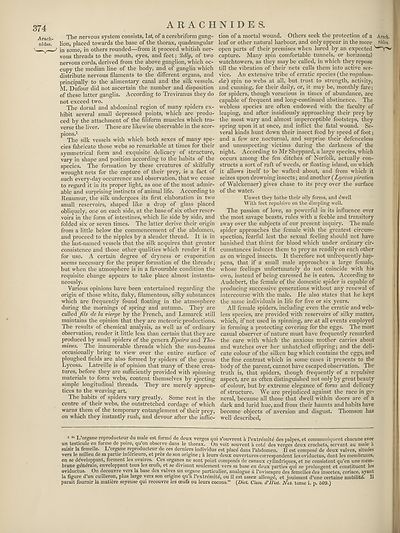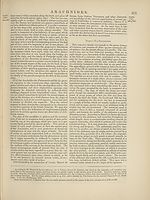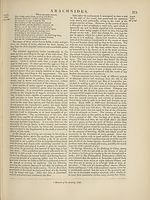Encyclopaedia Britannica > Volume 3, Anatomy-Astronomy
(382) Page 374
Download files
Complete book:
Individual page:
Thumbnail gallery: Grid view | List view

A R A C H
The nervous system consists, Is#, of a cerebriform gang¬
lion, placed towards the base of the thorax, quadrangular
in some, in others rounded—from it proceed whitish ner¬
vous threads to the mouth, eyes, and feet; 2c?/?/, of two
nervous cords, derived from the above ganglion, which oc¬
cupy the median line of the body, and of ganglia which
distribute nervous filaments to the different organs, and
principally to the alimentary canal and the silk vessels.
M. Dufour did not ascertain the number and disposition
of these latter ganglia. According to Treviranus they do
not exceed two.
The dorsal and abdominal region of many spiders ex¬
hibit several small depressed points, which are produ¬
ced by the attachment of the filiform muscles which tra¬
verse the liver. These are likewise observable in the scor¬
pions.1
The silk vessels with which both sexes of many spe¬
cies fabricate those webs so remarkable at times for their
symmetrical form and exquisite delicacy of structure,
vary in shape and position according to the habits of the
species. The formation by these creatures of skilfully
wrought nets for the capture of their prey, is a fact of
such every-day occurrence and observation, that we cease
to regard it in its proper light, as one of the most admir¬
able and surprising instincts of animal life. According to
Reaumur, the silk undergoes its first elaboration in two
small reservoirs, shaped like a drop of glass placed
obliquely, one on each side, at the base of six other reser¬
voirs in the form of intestines, which lie side by side, and
folded six or seven times. The latter derive their origin
from a little below the commencement of the abdomen,
and proceed to the nipples by a slender thread. It is in
the last-named vessels that the silk acquires that greater
consistence and those other qualities which render it fit
for use. A certain degree of dryness or evaporation
seems necessary for the proper formation of the threads;
but when the atmosphere is in a favourable condition the
requisite change appears to take place almost instanta¬
neously.
Various opinions have been entertained regarding the
origin of those white, flaky, filamentous, silky substances
which are frequently found floating in the atmosphere
during the mornings of spring and autumn. They are
called fils de la vierge by the French, and Lamarck still
maintains the opinion that they are meteoric productions.
The results of chemical analysis, as well as of ordinary
observation, render it little less than certain that they are
produced by small spiders of the genera Epeira and Tho-
misus. The innumerable threads which the sun-beams
occasionally bring to view over the entire surface of
ploughed fields are also formed by spiders of the genus
Lycosa. Latreille is of opinion that many of these crea¬
tures, before they are sufficiently provided with spinning
materials to form webs, content themselves by ejecting
simple longitudinal threads. They are merely appren¬
tices to the weaving art.
The habits of spiders vary greatly. Some rest in the
centre of their webs, the outstretched cordage of which
warns them of the temporary entanglement of their prey,
on which they instantly rush, and devour after the inflic-
N I D E S.
tion of a mortal wound. Others seek the protection of a Arach-
leaf or other natural harbour, and only appear in the more nicies,
open parts of their premises when lured by an expected
capture. Many spin comfortable tunnels, or horizontal
watchtowers, as they maybe called, in which they repose
till the vibration of their nets calls them into active ser¬
vice. An extensive tribe of erratic species (the
dce) spin no webs at all, but trust to strength, activity,
and cunning, for their daily, or, it may be, monthly fare;
for spiders, though voracious in times of abundance, are
capable of frequent and long-continued abstinence. The
webless species are often endowed with the faculty of
leaping, and after insidiously approaching their prey by
the most wary and almost imperceptible footsteps, they
spring upon it at once, and inflict the fatal wound. Se¬
veral kinds hunt down their insect food by speed of foot;
and a few are nocturnal, and surprise their defenceless
and unsuspecting victims during the darkness of the
night. According to Mr Sheppard, a large species, which
occurs among the fen ditches of Norfolk, actually con¬
structs a sort of raft of weeds, or floating island, on which
it allows itself to be wafted about, and from which it
seizes upon drowning insects; and another (Egccsapiralica
of Walckenaer) gives chase to its prey over the surface
of the water.
Unwet they bathe their oily forms, and dwell
With feet repulsive on the dimpling well.
The passion of love, so powerful in its influence over
the most savage beasts, rules with a feeble and transitory
sway over the subjects of our present inquiry. The male
spider approaches the female with the greatest circum¬
spection, fearful lest the sexual feeling should not have
banished that thirst for blood which under ordinary cir¬
cumstances induces them to prey as readily on each other
as on winged insects. It therefore not unfrequently hap¬
pens, that if a small male approaches a large female,
whose feelings unfortunately do not coincide with his
own, instead of being caressed he is eaten. According to
Audebert, the female of the domestic spider is capable of
producing successive generations without any renewal of
intercourse with the male. He also states that he kept
the same individuals in life for five or six years.
All female spiders, including even the erratic and web¬
less species, are provided with reservoirs of silky matter,
which, if not used in spinning, are at all events employed
in forming a protecting covering for the eggs. The most
casual observer of nature must have frequently remarked
the care with which the anxious mother carries about
and watches over her unhatched offspring; and the deli¬
cate colour of the silken bag which contains the eggs, and
the fine contrast which in some cases it presents to the
body of the parent, cannot have escaped observation. The
truth is, that spiders, though frequently of a repulsive
aspect, are as often distinguished not only by great beauty
of colour, but by extreme elegance of form and delicacy
of structure. We are prejudiced against the race in ge¬
neral, because all those that dwell within doors are of a
dark and lurid hue, and from their haunts and habits have
become objects of aversion and disgust. Thomson has
well described,
1 “ L’organe reproducteur du male est forme de deux verges qui s’ouvrent a 1’extremitd des palpes, et communiquent chacune avec
un testicule en forme de poire, qu on observe dans le thorax. On voit souvent a cote des verges deux crochets, servant au male a
saisir la femelle. L’organe reproducteur de ces derniers individus est place dans 1’abdomen. II est compose de deux valves, situe'es
vers le milieu de sa partie inferieure, et pres de son origine; a leurs deux ouvertures correspondent les oviductus, dont les membranes,
en se deyeloppant, torment les ovaires. Ces organes ne sont point composes de canaux cylindriques, et ne consistent qu’en une mem¬
brane gendrale, enveloppant tous les ceufs, et se divisant seulement vers sa base en deux parties qui se prolongent et constituent les
oviductus. On decouvre vers la base des valves un organe particulier, analogue a 1’oviscapre des femelles des insectes, coriace, ayant
la figure d’un cuilleron, plus large vers son origine qu a 1’extremitd, ou il est assez allonge, et jouissant d’une certaine mobilitd. 11
parait fournir la matiere soyeuse qui recouvre les oeufs ou leurs cocons.” (Did. Class. d'Hist. Nat. tome i. p. 509.)
The nervous system consists, Is#, of a cerebriform gang¬
lion, placed towards the base of the thorax, quadrangular
in some, in others rounded—from it proceed whitish ner¬
vous threads to the mouth, eyes, and feet; 2c?/?/, of two
nervous cords, derived from the above ganglion, which oc¬
cupy the median line of the body, and of ganglia which
distribute nervous filaments to the different organs, and
principally to the alimentary canal and the silk vessels.
M. Dufour did not ascertain the number and disposition
of these latter ganglia. According to Treviranus they do
not exceed two.
The dorsal and abdominal region of many spiders ex¬
hibit several small depressed points, which are produ¬
ced by the attachment of the filiform muscles which tra¬
verse the liver. These are likewise observable in the scor¬
pions.1
The silk vessels with which both sexes of many spe¬
cies fabricate those webs so remarkable at times for their
symmetrical form and exquisite delicacy of structure,
vary in shape and position according to the habits of the
species. The formation by these creatures of skilfully
wrought nets for the capture of their prey, is a fact of
such every-day occurrence and observation, that we cease
to regard it in its proper light, as one of the most admir¬
able and surprising instincts of animal life. According to
Reaumur, the silk undergoes its first elaboration in two
small reservoirs, shaped like a drop of glass placed
obliquely, one on each side, at the base of six other reser¬
voirs in the form of intestines, which lie side by side, and
folded six or seven times. The latter derive their origin
from a little below the commencement of the abdomen,
and proceed to the nipples by a slender thread. It is in
the last-named vessels that the silk acquires that greater
consistence and those other qualities which render it fit
for use. A certain degree of dryness or evaporation
seems necessary for the proper formation of the threads;
but when the atmosphere is in a favourable condition the
requisite change appears to take place almost instanta¬
neously.
Various opinions have been entertained regarding the
origin of those white, flaky, filamentous, silky substances
which are frequently found floating in the atmosphere
during the mornings of spring and autumn. They are
called fils de la vierge by the French, and Lamarck still
maintains the opinion that they are meteoric productions.
The results of chemical analysis, as well as of ordinary
observation, render it little less than certain that they are
produced by small spiders of the genera Epeira and Tho-
misus. The innumerable threads which the sun-beams
occasionally bring to view over the entire surface of
ploughed fields are also formed by spiders of the genus
Lycosa. Latreille is of opinion that many of these crea¬
tures, before they are sufficiently provided with spinning
materials to form webs, content themselves by ejecting
simple longitudinal threads. They are merely appren¬
tices to the weaving art.
The habits of spiders vary greatly. Some rest in the
centre of their webs, the outstretched cordage of which
warns them of the temporary entanglement of their prey,
on which they instantly rush, and devour after the inflic-
N I D E S.
tion of a mortal wound. Others seek the protection of a Arach-
leaf or other natural harbour, and only appear in the more nicies,
open parts of their premises when lured by an expected
capture. Many spin comfortable tunnels, or horizontal
watchtowers, as they maybe called, in which they repose
till the vibration of their nets calls them into active ser¬
vice. An extensive tribe of erratic species (the
dce) spin no webs at all, but trust to strength, activity,
and cunning, for their daily, or, it may be, monthly fare;
for spiders, though voracious in times of abundance, are
capable of frequent and long-continued abstinence. The
webless species are often endowed with the faculty of
leaping, and after insidiously approaching their prey by
the most wary and almost imperceptible footsteps, they
spring upon it at once, and inflict the fatal wound. Se¬
veral kinds hunt down their insect food by speed of foot;
and a few are nocturnal, and surprise their defenceless
and unsuspecting victims during the darkness of the
night. According to Mr Sheppard, a large species, which
occurs among the fen ditches of Norfolk, actually con¬
structs a sort of raft of weeds, or floating island, on which
it allows itself to be wafted about, and from which it
seizes upon drowning insects; and another (Egccsapiralica
of Walckenaer) gives chase to its prey over the surface
of the water.
Unwet they bathe their oily forms, and dwell
With feet repulsive on the dimpling well.
The passion of love, so powerful in its influence over
the most savage beasts, rules with a feeble and transitory
sway over the subjects of our present inquiry. The male
spider approaches the female with the greatest circum¬
spection, fearful lest the sexual feeling should not have
banished that thirst for blood which under ordinary cir¬
cumstances induces them to prey as readily on each other
as on winged insects. It therefore not unfrequently hap¬
pens, that if a small male approaches a large female,
whose feelings unfortunately do not coincide with his
own, instead of being caressed he is eaten. According to
Audebert, the female of the domestic spider is capable of
producing successive generations without any renewal of
intercourse with the male. He also states that he kept
the same individuals in life for five or six years.
All female spiders, including even the erratic and web¬
less species, are provided with reservoirs of silky matter,
which, if not used in spinning, are at all events employed
in forming a protecting covering for the eggs. The most
casual observer of nature must have frequently remarked
the care with which the anxious mother carries about
and watches over her unhatched offspring; and the deli¬
cate colour of the silken bag which contains the eggs, and
the fine contrast which in some cases it presents to the
body of the parent, cannot have escaped observation. The
truth is, that spiders, though frequently of a repulsive
aspect, are as often distinguished not only by great beauty
of colour, but by extreme elegance of form and delicacy
of structure. We are prejudiced against the race in ge¬
neral, because all those that dwell within doors are of a
dark and lurid hue, and from their haunts and habits have
become objects of aversion and disgust. Thomson has
well described,
1 “ L’organe reproducteur du male est forme de deux verges qui s’ouvrent a 1’extremitd des palpes, et communiquent chacune avec
un testicule en forme de poire, qu on observe dans le thorax. On voit souvent a cote des verges deux crochets, servant au male a
saisir la femelle. L’organe reproducteur de ces derniers individus est place dans 1’abdomen. II est compose de deux valves, situe'es
vers le milieu de sa partie inferieure, et pres de son origine; a leurs deux ouvertures correspondent les oviductus, dont les membranes,
en se deyeloppant, torment les ovaires. Ces organes ne sont point composes de canaux cylindriques, et ne consistent qu’en une mem¬
brane gendrale, enveloppant tous les ceufs, et se divisant seulement vers sa base en deux parties qui se prolongent et constituent les
oviductus. On decouvre vers la base des valves un organe particulier, analogue a 1’oviscapre des femelles des insectes, coriace, ayant
la figure d’un cuilleron, plus large vers son origine qu a 1’extremitd, ou il est assez allonge, et jouissant d’une certaine mobilitd. 11
parait fournir la matiere soyeuse qui recouvre les oeufs ou leurs cocons.” (Did. Class. d'Hist. Nat. tome i. p. 509.)
Set display mode to:
![]() Universal Viewer |
Universal Viewer | ![]() Mirador |
Large image | Transcription
Mirador |
Large image | Transcription
Images and transcriptions on this page, including medium image downloads, may be used under the Creative Commons Attribution 4.0 International Licence unless otherwise stated. ![]()
| Encyclopaedia Britannica > Encyclopaedia Britannica > Volume 3, Anatomy-Astronomy > (382) Page 374 |
|---|
| Permanent URL | https://digital.nls.uk/193762314 |
|---|
| Attribution and copyright: |
|
|---|---|
| Shelfmark | EB.16 |
|---|---|
| Description | Ten editions of 'Encyclopaedia Britannica', issued from 1768-1903, in 231 volumes. Originally issued in 100 weekly parts (3 volumes) between 1768 and 1771 by publishers: Colin Macfarquhar and Andrew Bell (Edinburgh); editor: William Smellie: engraver: Andrew Bell. Expanded editions in the 19th century featured more volumes and contributions from leading experts in their fields. Managed and published in Edinburgh up to the 9th edition (25 volumes, from 1875-1889); the 10th edition (1902-1903) re-issued the 9th edition, with 11 supplementary volumes. |
|---|---|
| Additional NLS resources: |
|

